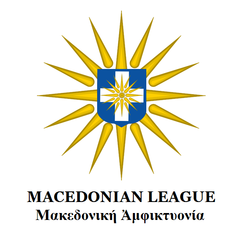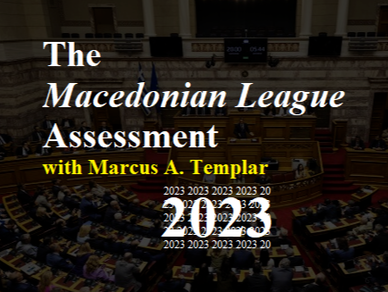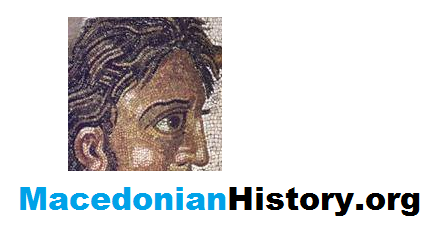Marcus A. Templar, National Security Advisor | Macedonian League
 Photo credit: Marcus A. Templar
Photo credit: Marcus A. TemplarNational Security Advisor, Macedonian League
The FYROM international organization United “Macedonian” Diaspora (UMD) that works in the same manner as their ancestors the Bulgarian Komitajis were doing at the beginning of the 20th century has launched a libelous campaign against Greece. Because UMD seems to be suffering from dementia I want to explain a few things for the record.
Historical Background
During the 4th century, the incursions of the Huns in Europe forced waves of Slavs and Germans to migrate. Germans migrated to the Danube and the Mediterranean as early as the year 375, but the Germans of Yugoslavia relocated to their respective areas approximately 800 years ago. Between the time of their migration to Yugoslavia and WW I the Swabian Germans lived in Austro-Hungarian held territories as Vojvodina, Croatia, Slovenia, and Bosnia and Herzegovina.
Because of the loss of Austro-Hungarian territories to newly formed states, the Swabian Germans were forced to separate into three different chauvinistic countries Hungary (700,000), Yugoslavia (550,000), and Romania (350,000). The new states were not very understanding of the fact that these people did not have any contact with Germany over the centuries, making them the scapegoat that paid for the Third Reich Germans’ brutality in the eastern occupied countries.
Communist Yugoslavia Sweeps Societal Ills
While the Axis forces occupied Yugoslavia, the “Anti-Fascist Council of the People's Liberation of Yugoslavia” known by its Serbo-Croatian acronym AVNOJ, met on November 26, 1942, at Bihać (First Session), Bosnia under Josip Broz Tito, in the hope of gaining political legitimacy, proclaiming support for:
1. democracy;
2. the rights of ethnic minorities;
3. the inviolability of private property; and
4. freedom of individual economic initiative for the different groups.
Despite the above statements, the new class felt the need to efface many of their perceived societal “ills,” one which was the Swabian Germans. On 21 Nov. 1943 (Second Session), the AVNOJ made sure that the above “ills” had to be eliminated issuing a proclamation ‘On the Deprivation of Civil Rights’ Act, depriving the people of German ancestry (Swabian Germans) of ALL human rights, including the right to live! The above Act formed the legal basis for the treatment of the Germans in Yugoslavia, including the creation of many labor and concentration camps:
1. All persons of German ethnicity living in Yugoslavia automatically lose their Yugoslavian citizenship as well as all civil rights.
2. The entire movable and immovable possessions of all persons of German ethnicity are confiscated by the state and henceforth its property.
3. Persons of German ethnicity are allowed neither to claim, or exercise any rights nor to use courts or other institutions for their personal or legal protection.
The above decision did not apply to all citizens of the new Yugoslavia. People that committed no crime against the state, Swabian Germans, by now 650,000 of them, the most significant non-Slavic ethnic group in pre-war Yugoslavia, were denied and deprived of all human rights, including the right to life. The result was that in 1944, Germans were stripped of their Yugoslavian citizenship; their property was also confiscated. Their property was to be distributed among Tito's rough, illiterate fighters who were his primary support.
Approximately 27,000 to 37,000 Germans were deported to the Soviet Union, and others were placed into concentration camps, which had been made from Swabian villages. The result of this deed was that 35,000 to 45,000 children were separated from their parents. Thousands died in the camps from starvation, malnutrition, and disease, but thousands as well escaped and went to Germany. The camps were finally closed in 1948, and from 1952[1] to 1955, the survivors were resettled in Germany by the International Red Cross. Only ten percent of the pre-war German population remained in Yugoslavia.[2]
One of the Swabian villages that all Greeks are very familiar with is Bulkes.[3] Settled by German colonists in 1786, the inhabitants of the town never thought that one day their ancestors would be forced to join murderous Waffen SS units, which did not operate in Yugoslavia, but in German-occupied territories of the USSR.[4] Subsequently, in retaliation of their involuntary “participation” to the Waffen SS that managed in regions of the USSR and not in Yugoslavia, they were tortured, mutilated, killed, uprooted and dispersed to the four corners of the Earth.
These horrendous actions took place under the auspices of an organization that declared democracy, rights of ethnic minorities, the inviolability of private property, and freedom of individual economic initiative for the different groups. One must have in mind that not only men of Swabian extract underwent such inhumane indiscriminate retribution, but also children, women, and old people, as well as the handicap.
Communist Yugoslavia Kidnaps Greek Children
After the elimination of the Swabian Germans from Bulkes (present-day Bački Maglić) the empty town became the most known town inhabited by Greek communists of the “Democratic Army” and their families and some of the kidnapped Greek children.[5]
The kidnapping of Greek children was a tactics that Ottomans used in order to man loyal soldiers to the Sultan. Those soldiers are known as Janissary. The communists established the same institution in order to brainwash Greek children, train them and then send them back to Greece in order to spread the spirit of communism. Although the policy was established in Moscow, the strategy was formulated in Belgrade, but the tactics was left to Skopje which not only directed the footwork, but became the distribution center of the future destabilization of Greece, Greece’s own children.
According to official accounts, the total number of children victims of kidnapped during the civil war of Greece were 24,871 children in 1948, 5006 children in 1949; in 1950, no kidnapping was reported bringing the total kidnapped children to 29,877.[6]
Dominique Eudes in the chapter “The Greek Children” (The Kapetanios) mentions that according to the Red Cross reports, there were 23,693 of them: 10,000 in Yugoslavia, 3,801 in Rumania, 3,800 in Hungary,[7] 2,660 in Bulgaria, 2,235 in Czechoslovakia and 2000 in Albania.[8] Ristovic on the other hand indicates that, "In January of 1950 there were 2000 children in Bulgaria, 3,500 in Czechoslovakia, 3,000 in Hungary, 500 in Poland, 6,500 in Romania, and 11,000 in Yugoslavia, a total of 26,500 children."[9]
But the actual number of these children who lived to see the end of the tragedy known to the Greeks as Paedomazoma or “gathering of children” is unknown as the Red Cross and the UN estimated their number to 28,000. Unknown also is the number of Greek children transferred to the USSR most of them to Uzbekistan. It has to be noted that the kidnapped children originated from all parts of Greece, from areas that the communists had even temporarily exercised control, not just the Greek region of Macedonia [10],[11]
According to other sources the children, their number and their locations are: 18.500 went to Bulgaria (17 camps), Romania (11 camps), Hungary (11 camps), Czechoslovakia (18 camps), Poland (3 camps), East Germany and Albania (5 camps), 9.500 went in Yugoslavia (15 camps). Those numbers and the locations are recorded also by the Red Cross.[12]
On November 17, 1948 (UN Resolution 193), and also in November 1949 (UN Resolution 288) the UN General assembly passed unanimously two resolutions condemning the removal of the Greek children, demanding their return. These and subsequent UN resolutions were not answered. From 1950 to 1952 only 684 children were permitted to return to Greece because of the pressure of the Red Cross and two new UN Resolutions.[13]
In an effort to protect Greek children from being kidnapped by the communists, the Greek government under the auspices of the then Queen Frederica organized the camps for children of all ages known as Paidopoleis. It was a network of 53 Camps all over Greece where mostly orphans and children of poor families were housed and educated. The camps were the only means of survival through shelter, food, and education.
According to some sources, the number of Greek children gathered in Paidopoleis was 25,000 (Βερβενιώτη 1999; Catherine Panter-Brick 2000; Καμπύλης 2008). The irony of the whole thing is that the communists who violated every single human right of the same children accused the system of anti-communist propaganda because of its education. In essence, the pot called the kettle black. Queen Frederica’s act alone saved thousands of children from being taken away from their homeland and their relatives.
As for Skopje, the acts of the AVNOJ (the expulsion of the Swabian Germans and the kidnapping of Greek children) were not only acceptable, but Skopje additionally supported them because all the horrific deeds took place in the name of socialism/communism. The expulsion of the Swabian Germans, however, has instituted a legal precedent that goes against those of the Skopjan diaspora who claim loss of property against Greece and mandatory expulsion, neither of which is true. Despite the nonsense that they are fed by their communist parents, Greece had never expelled them for their treason against her; they had left on their own in order to avoid criminal persecution and believing the rumors their own communists friends were spreading. Communist Yugoslavia deliberately had expelled its own citizens, the “Swabian Germans” due to their race, language, and heritage and not due to any criminal activity, and the country went unpunished. That act has established an international legal precedent.
The following statement was taken from an anti-Hellenic Australian-based website. It is prepared by Mr. Atanas Strezovski under the title “My First Visit To My Birthplace, The Village Neret Near Lerin in Aegean Macedonia,” in Greece. At a point Mr. Strezovski states,
Historical Background
During the 4th century, the incursions of the Huns in Europe forced waves of Slavs and Germans to migrate. Germans migrated to the Danube and the Mediterranean as early as the year 375, but the Germans of Yugoslavia relocated to their respective areas approximately 800 years ago. Between the time of their migration to Yugoslavia and WW I the Swabian Germans lived in Austro-Hungarian held territories as Vojvodina, Croatia, Slovenia, and Bosnia and Herzegovina.
Because of the loss of Austro-Hungarian territories to newly formed states, the Swabian Germans were forced to separate into three different chauvinistic countries Hungary (700,000), Yugoslavia (550,000), and Romania (350,000). The new states were not very understanding of the fact that these people did not have any contact with Germany over the centuries, making them the scapegoat that paid for the Third Reich Germans’ brutality in the eastern occupied countries.
Communist Yugoslavia Sweeps Societal Ills
While the Axis forces occupied Yugoslavia, the “Anti-Fascist Council of the People's Liberation of Yugoslavia” known by its Serbo-Croatian acronym AVNOJ, met on November 26, 1942, at Bihać (First Session), Bosnia under Josip Broz Tito, in the hope of gaining political legitimacy, proclaiming support for:
1. democracy;
2. the rights of ethnic minorities;
3. the inviolability of private property; and
4. freedom of individual economic initiative for the different groups.
Despite the above statements, the new class felt the need to efface many of their perceived societal “ills,” one which was the Swabian Germans. On 21 Nov. 1943 (Second Session), the AVNOJ made sure that the above “ills” had to be eliminated issuing a proclamation ‘On the Deprivation of Civil Rights’ Act, depriving the people of German ancestry (Swabian Germans) of ALL human rights, including the right to live! The above Act formed the legal basis for the treatment of the Germans in Yugoslavia, including the creation of many labor and concentration camps:
1. All persons of German ethnicity living in Yugoslavia automatically lose their Yugoslavian citizenship as well as all civil rights.
2. The entire movable and immovable possessions of all persons of German ethnicity are confiscated by the state and henceforth its property.
3. Persons of German ethnicity are allowed neither to claim, or exercise any rights nor to use courts or other institutions for their personal or legal protection.
The above decision did not apply to all citizens of the new Yugoslavia. People that committed no crime against the state, Swabian Germans, by now 650,000 of them, the most significant non-Slavic ethnic group in pre-war Yugoslavia, were denied and deprived of all human rights, including the right to life. The result was that in 1944, Germans were stripped of their Yugoslavian citizenship; their property was also confiscated. Their property was to be distributed among Tito's rough, illiterate fighters who were his primary support.
Approximately 27,000 to 37,000 Germans were deported to the Soviet Union, and others were placed into concentration camps, which had been made from Swabian villages. The result of this deed was that 35,000 to 45,000 children were separated from their parents. Thousands died in the camps from starvation, malnutrition, and disease, but thousands as well escaped and went to Germany. The camps were finally closed in 1948, and from 1952[1] to 1955, the survivors were resettled in Germany by the International Red Cross. Only ten percent of the pre-war German population remained in Yugoslavia.[2]
One of the Swabian villages that all Greeks are very familiar with is Bulkes.[3] Settled by German colonists in 1786, the inhabitants of the town never thought that one day their ancestors would be forced to join murderous Waffen SS units, which did not operate in Yugoslavia, but in German-occupied territories of the USSR.[4] Subsequently, in retaliation of their involuntary “participation” to the Waffen SS that managed in regions of the USSR and not in Yugoslavia, they were tortured, mutilated, killed, uprooted and dispersed to the four corners of the Earth.
These horrendous actions took place under the auspices of an organization that declared democracy, rights of ethnic minorities, the inviolability of private property, and freedom of individual economic initiative for the different groups. One must have in mind that not only men of Swabian extract underwent such inhumane indiscriminate retribution, but also children, women, and old people, as well as the handicap.
Communist Yugoslavia Kidnaps Greek Children
After the elimination of the Swabian Germans from Bulkes (present-day Bački Maglić) the empty town became the most known town inhabited by Greek communists of the “Democratic Army” and their families and some of the kidnapped Greek children.[5]
The kidnapping of Greek children was a tactics that Ottomans used in order to man loyal soldiers to the Sultan. Those soldiers are known as Janissary. The communists established the same institution in order to brainwash Greek children, train them and then send them back to Greece in order to spread the spirit of communism. Although the policy was established in Moscow, the strategy was formulated in Belgrade, but the tactics was left to Skopje which not only directed the footwork, but became the distribution center of the future destabilization of Greece, Greece’s own children.
According to official accounts, the total number of children victims of kidnapped during the civil war of Greece were 24,871 children in 1948, 5006 children in 1949; in 1950, no kidnapping was reported bringing the total kidnapped children to 29,877.[6]
Dominique Eudes in the chapter “The Greek Children” (The Kapetanios) mentions that according to the Red Cross reports, there were 23,693 of them: 10,000 in Yugoslavia, 3,801 in Rumania, 3,800 in Hungary,[7] 2,660 in Bulgaria, 2,235 in Czechoslovakia and 2000 in Albania.[8] Ristovic on the other hand indicates that, "In January of 1950 there were 2000 children in Bulgaria, 3,500 in Czechoslovakia, 3,000 in Hungary, 500 in Poland, 6,500 in Romania, and 11,000 in Yugoslavia, a total of 26,500 children."[9]
But the actual number of these children who lived to see the end of the tragedy known to the Greeks as Paedomazoma or “gathering of children” is unknown as the Red Cross and the UN estimated their number to 28,000. Unknown also is the number of Greek children transferred to the USSR most of them to Uzbekistan. It has to be noted that the kidnapped children originated from all parts of Greece, from areas that the communists had even temporarily exercised control, not just the Greek region of Macedonia [10],[11]
According to other sources the children, their number and their locations are: 18.500 went to Bulgaria (17 camps), Romania (11 camps), Hungary (11 camps), Czechoslovakia (18 camps), Poland (3 camps), East Germany and Albania (5 camps), 9.500 went in Yugoslavia (15 camps). Those numbers and the locations are recorded also by the Red Cross.[12]
On November 17, 1948 (UN Resolution 193), and also in November 1949 (UN Resolution 288) the UN General assembly passed unanimously two resolutions condemning the removal of the Greek children, demanding their return. These and subsequent UN resolutions were not answered. From 1950 to 1952 only 684 children were permitted to return to Greece because of the pressure of the Red Cross and two new UN Resolutions.[13]
In an effort to protect Greek children from being kidnapped by the communists, the Greek government under the auspices of the then Queen Frederica organized the camps for children of all ages known as Paidopoleis. It was a network of 53 Camps all over Greece where mostly orphans and children of poor families were housed and educated. The camps were the only means of survival through shelter, food, and education.
According to some sources, the number of Greek children gathered in Paidopoleis was 25,000 (Βερβενιώτη 1999; Catherine Panter-Brick 2000; Καμπύλης 2008). The irony of the whole thing is that the communists who violated every single human right of the same children accused the system of anti-communist propaganda because of its education. In essence, the pot called the kettle black. Queen Frederica’s act alone saved thousands of children from being taken away from their homeland and their relatives.
As for Skopje, the acts of the AVNOJ (the expulsion of the Swabian Germans and the kidnapping of Greek children) were not only acceptable, but Skopje additionally supported them because all the horrific deeds took place in the name of socialism/communism. The expulsion of the Swabian Germans, however, has instituted a legal precedent that goes against those of the Skopjan diaspora who claim loss of property against Greece and mandatory expulsion, neither of which is true. Despite the nonsense that they are fed by their communist parents, Greece had never expelled them for their treason against her; they had left on their own in order to avoid criminal persecution and believing the rumors their own communists friends were spreading. Communist Yugoslavia deliberately had expelled its own citizens, the “Swabian Germans” due to their race, language, and heritage and not due to any criminal activity, and the country went unpunished. That act has established an international legal precedent.
The following statement was taken from an anti-Hellenic Australian-based website. It is prepared by Mr. Atanas Strezovski under the title “My First Visit To My Birthplace, The Village Neret Near Lerin in Aegean Macedonia,” in Greece. At a point Mr. Strezovski states,
We started again for Bitola [Monastiri] and my cousin said to me “Oh cousin, Tanase, if you had stayed here instead of emigrating you would have a house in Neret [Polypotamos], a farm in Neret, and a shop in Lerin [Florina]. Because your family was not here your grandfather Hristos gave everything to us and made us promise we would not sell the shop to anyone.”[14]
The above statement - confession is just one example of the many that exonerate Greece from all accusations of property confiscation. No Greek government ever confiscated their properties but they voluntarily gave them to their own relatives, and since they had left Greece and stayed out of the country for more than 28 years, their properties have legally passed to those who were their caretakers. It is the law of the land and applies to all.
Communist Yugoslavia deliberately had expelled its own citizens due to their race, language, and heritage and not due to any criminal activity, and the country went unpunished. That act has established an international legal precedent. Because of it, not one Court would prosecute another state, i.e. Greece, with legitimate criminal grievances against the FYROM Slavs who took arms against it, facilitated the kidnapping of Greek children as documented by the International Red Cross and the UNSC, and then left the country on their own accord in order to avoid criminal prosecution.
____________________
[1] For details see Dominique Eudes The Kapetanios; Milan Ristović, Long Return Home, Children Refugees from Greece in Yugoslavia 1948-1960), and Milan Ristovic, Experiment Bulkes: “The Hellenic Republic” in Yugoslavia (1945 – 1949); Ioannis Bougas, The Cry of Irene (Thessaloniki, Erodios 2006); Stéphane Courtois, Nicholas Werth, etc., The Black Book Of Communism. Trans. by Jonathan Murphy and Mark Kramer. (Cambridge: Harvard University Press, 1999), 326 – 331.
[2] Susan Clarkson, “History of German Settlements in Southern Hungary.” http://www.banaters.com/banat/clarkson.asp?category=history (accessed September 22, 2011);
Frank Schmidt, The Swabians: Southeastern Europe’s Forgotten Victims, 2008. http://www.read-all-about-it.org/archive_english/genocide_in_yugoslavia/the_swabians.html. (accessed September 22, 2011).
[3] Bulkes in the Batschka, http://www.swabiantrek.com/?page_id=136; also Marián Sloboda, Bački Maglić (Buljkes) i grčka komuna u Vojvodini prije odlaska u Čehoslovačku 1945–1949, http://www.sloboda.cz/marian/publikace/maglic.pdf (accessed September 22, 2011).
[4] On the contrary, the Bosnian Muslim Handjar Division aka 13th Waffen Mountain Division of the SS Handschar (1st Croatian) was a units of volunteers and fought in Bosnia against the Yugoslav communists. In addition, the Croatian 369th Reinforced Infantry Regiment, 369th "Devil's" Division, 373rd "Tiger" Division, 392nd "Blue" Division, the Croatian Air Force Legion, the Croatian Naval Legion, the 23rd Waffen SS Mountain Division "Kama", "Croatia" Police Regiments 1, 2, 3, 4, and 5, Police Anti-Tank Company "Croatia", and Gendarmerie Division "Croatia," served within and outside Yugoslavia. The Light Transport Brigade and Croatian Legion both served under Italy during WWII.
[5][5]
[6] Colonel T. Papathanasiades, "The Bandits' Last Stand in Greece." Edited by Colonel H. R. Emery. U.S. Military Review, Vol. XXX, Number 11, February 1951: 22 – 31.
[7] Esther Vécsey, The Greeks of Hungary (Victims of Cold War Communist kidnappings), Free Republic, February 26, 2004 (Posted on Sunday, March 07, 2004 11:32:49 PM by Destro. February 26, 2004 - Volume XII, Issue 9. http://www.freerepublic.com/focus/f-news/1092902/posts (accessed November 28, 2011)
[8] Dominique Eudes, The Kapetanios. Partisans and Civil War in Greece...1943-1949 (London: Monthly Review, 1972) 317.
[9] Milan Ristovic, Long Return Home, Children Refugees from Greece in Yugoslavia 1948-1960, (Thessaloniki: Institute for Balkan Studies, 2000), 95.
[10] United States of America
House of Representatives
House Resolution 514
Resolved, That
the House of Representatives expresses its profound concern for the thousands of Greek children removed or carried off into countries of eastern Europe by the Communist guerrilla forces during the course of the recent guerrilla warfare in Greece, and requests the President to exert all of his powers, acting through the United Nations and other international organizations and directly with the governments of the countries where these children are located, to the end that these thousands of children shall be speedily returned to their homes and homeland .
Sam Rayburn,
Speaker of the House of Representatives,
[11] Harry S. Truman
XXXIII President of the United States
April 19th, 1950
[Released April 19, 1950. Dated April 18, 1950]
My dear Mr. Speaker:
I fully share the concern of the House of Representatives for the thousands of children removed from Greece to eastern Europe by the communist guerrilla forces, and I welcome the adoption of House Resolution 514 of March 22, 1950, calling for the speedy return of these children to their homes and homeland.
The rights of children and parents to share the protection, comradeship and beneficent influence of a family home are fundamental and have been implicitly recognized, in the case of the Greek children, in two unanimous resolutions of the United Nations General Assembly. It is morally inadmissible that political considerations or technical difficulties should be allowed to stand in the way of the reunion of these children with their parents.
The Executive Branch of the Government has been persistent in its endeavors to secure effective compliance with the United Nations resolutions in this case. These efforts will not be relaxed until the Greek children are back in their homes.
Very sincerely yours,
HARRY S. TRUMAN
[12] (Manoukas, Child Gathering Vol I, The Biggest Crime, 1961) (Manoukas, Child Gathering Vol II, Education and Teaching of the kidnapping Greek children, 1967).
[13] References:
1) Child Gathering Vol I, The Biggest Crime, Georgios Manoukas, 1961
2) Child Gathering Vol II, Education and Teaching of the kidnapping Greek children, Georgios Manoukas, 1967. Text as appears in the Journal of Original Thinking, http://journaloforiginalthinking.com/pb/wp_dc73f750/wp_dc73f750.html (accessed November 29, 2011).
[14] Atanas Strezovski under the title “My First Visit to My Birthplace, The Village Neret near Lerin in Aegean Macedonia.”
http://www.pollitecon.com/html/life/My_First_Visit_To_My_Birthplace.html (accessed September 23, 2011).
_____
About Marcus A. Templar
Professor Marcus A. Templar is a former U.S. Army Cryptologic Linguist (Language Analyst), Certified U.S. Army Instructor of Intelligence Courses, Certified Foreign Disclosures Officer, Certified Translator Interpreter of Serbo-Croatian, SIGINT / All-Source Intelligence Analyst. He is the Macedonian League's National Security Advisor.
To read all his papers, please click here.
About the Macedonian League
We are an international professional Hellenic advocacy group. Our primary purpose is to advance our interests to informed and responsive governments on issues concerning Greece's national security and territorial integrity.
The Macedonian League's main focus is on the “Macedonian name dispute”, as this dispute is a serious national security issue that threatens the territorial integrity of Greece.
The Macedonian League also focuses on exposing and combating anti-Hellenism and analyzing political developments in the Former Yugoslav Republic of Macedonia.
For more information, follow us on: Website, Facebook, Twitter
Department of Communications
Macedonian League




 RSS Feed
RSS Feed